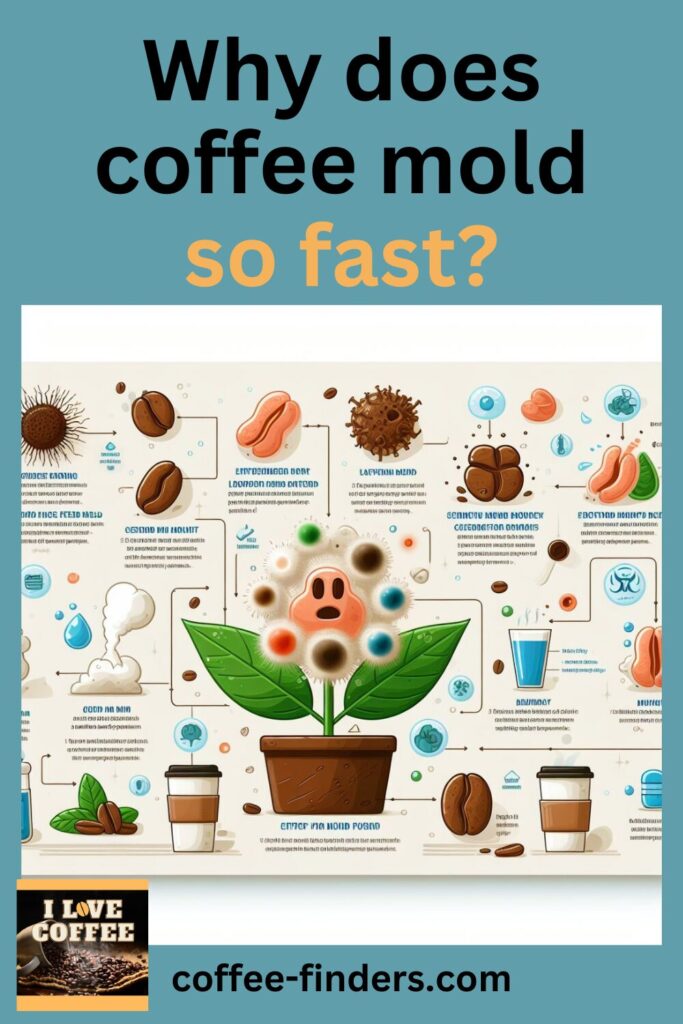Hi, coffee lovers! I’m back with another interesting topic for you. Today, I want to talk about something that may have happened to you at some point: coffee mold.
Have you ever left a cup of coffee on the counter for too long and noticed some fuzzy stuff growing on it? Or have you ever opened a bag of coffee beans or grounds and found some green or black spots on them? If so, you have encountered coffee mold.
| Why does coffee mold so fast? Short version |
|---|
| Coffee mold is a common problem that can affect brewed coffee, coffee beans, and coffee grounds. It occurs when molds — tiny fungi that are found in the environment — grow on the coffee due to moisture, warmth, nutrients, and acidity. |
Coffee mold is a common problem that can affect brewed coffee, coffee beans, and coffee grounds. It occurs when molds — tiny fungi that are found in the environment — grow on the coffee due to moisture, warmth, nutrients, and acidity.
But why does coffee mold so fast? And is it harmful to your health? And how can you prevent it? In this post, I will answer these questions and more. Let’s get started!
In this blog post we will look at the following:
Why does coffee mold so fast? Longer version
Mold can grow on coffee relatively fast because coffee provides an ideal environment for mold spores to thrive.
The 4 factors that contribute to coffee mold are:
- Moisture. Mold needs water to grow, and coffee is mostly water. If coffee is left in a pot, mug, or carafe for too long, it can become a breeding ground for mold. Coffee beans and grounds can also absorb moisture from the air, especially in humid climates.
- Warmth. Mold prefers warm temperatures, and coffee is usually brewed hot. If coffee is not consumed or refrigerated soon after brewing, it can cool down to a temperature that is favorable for mold growth. Coffee beans and grounds can also be affected by the ambient temperature of the storage area.
- Nutrients. Mold feeds on organic matter, and coffee contains plenty of nutrients for mold to use. Coffee beans and grounds have oils, sugars, proteins, and other compounds that mold can digest. Brewed coffee also has some of these nutrients, as well as any additives like milk, cream, or sugar.
- Acidity. Mold likes slightly acidic environments, and coffee is naturally acidic. The pH of coffee ranges from 5.2 to 6.9, depending on the type, roast, and brewing method of the coffee. This pH level is close to the optimal range for mold growth, which is between 6 and 7.

So, as you can see, coffee is a perfect food for mold. That’s why it can grow so fast on it.
Is coffee mold harmful to your health?
Mold can produce toxins called mycotoxins, which can cause various health problems when ingested in large amounts. Some of the most common mycotoxins found in coffee are aflatoxin B1 and ochratoxin A.
Aflatoxin B1 is a known carcinogen and has been shown to have various harmful effects, such as liver damage, immune suppression, and growth impairment. Ochratoxin A has been less studied, but it’s believed to be a weak carcinogen that may be harmful to your kidneys.
However, before you panic, you should know that the levels of mycotoxins in coffee are usually very low and below the safety limit set by most countries. This is because coffee undergoes several processing steps that can reduce or eliminate the mold and the mycotoxins, such as washing, drying, roasting, and brewing.
Also, your liver can detoxify small amounts of mycotoxins, so they do not accumulate in your body. Therefore, the risk of getting sick from coffee mold is very low, unless you consume a lot of moldy coffee or have a compromised immune system.
Still, it’s better to be safe than sorry. So, if you see or smell any signs of mold in your coffee, you should discard it immediately. Do not drink or reuse moldy coffee, as it may contain harmful mycotoxins that can cause health problems.
Check this post: Stay Away From These European Coffee Brands (And 13 You Should Try)
How can you prevent coffee mold?
The best way to prevent coffee mold is to store and consume your coffee properly. Here are some tips to avoid coffee mold:

- Brew only as much coffee as you need, and drink it within an hour or two of brewing. If you want to save some coffee for later, refrigerate it in an airtight container and reheat it when needed.
- Clean your coffee maker, pot, mug, and carafe regularly with hot water and soap, or vinegar and baking soda. Rinse them well and dry them thoroughly before using them again.
- Store coffee beans and grounds in a cool, dry, and dark place, such as a pantry or cabinet. Use an airtight container or a resealable bag to keep out moisture and air. Consume them within a month of opening, or freeze them for longer storage.
- Buy coffee from reputable sources that follow good hygiene and quality standards. Look for coffee that is certified organic, fair trade, or specialty grade, as these tend to have lower levels of mold and mycotoxins.
Have you been wondering about buying a new coffee machine that can brew both coffee and espresso? Have a look at my l’or coffee machine review.
Coffee from VietNam – What gives Vietnamese Coffee the extra punch?
Conclusion – Why does coffee mold so fast
Coffee mold is a common problem that can affect brewed coffee, coffee beans, and coffee grounds. It occurs when molds grow on the coffee due to moisture, warmth, nutrients, and acidity.
Coffee mold can grow relatively fast, and it can produce toxins called mycotoxins, which can cause health problems when ingested in large amounts. However, the risk of getting sick from coffee mold is very low, as the levels of mycotoxins in coffee are usually below the safety limit, and the processing steps of coffee can reduce or eliminate the mold and the mycotoxins.
Still, it’s better to prevent coffee mold by storing and consuming your coffee properly. If you see or smell any signs of mold in your coffee, you should discard it immediately.
I hope this post has helped you understand why does coffee mold so fast and how to avoid it. If you have any questions or comments, please feel free to leave them below. And if you enjoyed this post, please share it with your friends and family who love coffee as much as you do.
Thanks for reading, and happy coffee drinking! 😊

